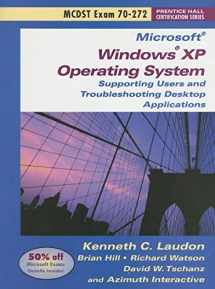
MCDST Exam 70-272: Supporting Users and Troubleshooting Desktop Applications on a Microsoft Windows XP Operating System
Book details
Summary
Description
MCDST Exam 70-272: Supporting Users and Troubleshooting Desktop Applications on a Microsoft Windows XP Operating System Table of Contents
1: Introducing Desktop Support
1.1 Examining the Desktop Support Role
1.2 Exploring Typical Desktop Support Environments and Positions
1.3 Understanding Professional Presentation and Customer Service Methods
1.4 Working with the User
1.5 Asking the Right Questions
1.6 Reproducing the Problem
1.7 Implementing a Troubleshooting Methodology
1.8 Helping the User Implement Solutions
2: Examiningthe Variety of Operating Systems
2.1 Introducing the Microsoft Windows Operating Systems: DOS
2.2 Understanding the MS Windows OS: Early Windows Operating Systems
2.3 Understanding the Microsoft Windows Operating Systems: Windows 95, Windows NT, and Windows 98
2.4 Understanding the Microsoft Windows Operating Systems: Windows 2000, Windows ME, and Windows XP
2.5 Understanding Linux and Mac
2.6 Working with File Systems
3: Configuring and Troubleshooting the Operating System to Support Applications
3.1 Personalizing the Start Menu and Task Bar
3.2 Troubleshooting the Start Menu and Task Bar
3.3 Working with File Associations
3.4 Customizing and Troubleshooting Folder Settings
3.5 Configuring Regional and Language Settings
3.6 Troubleshooting Regional and Language Settings
3.7 Using Windows XP Troubleshooting Tools
3.8 Updating the Operating System
3.9 Managing and Maintaining the Operating System
4: Supporting Applications
4.1 Understanding Application Support
4.2 Examining Common Application Categories
4.3 Installing Applications
4.4 Understanding Error Messages
4.5 Troubleshooting Application Compatibility
4.6 Supporting Legacy Applications
5: Supporting Internet Explorer
5.1 Customizing the Toolbar and Configuring General Settings in Internet Explorer
5.2 Implementing Accessibility and Languages Options in Internet Explorer
5.3 Exploring Security in Internet Explorer
5.4 Examining Privacy Options in Internet Explorer
5.5 Personalizing Content in Internet Explorer
5.6 Configuring Connectivity Options in Internet Explorer
5.7 Working with Program Options in Internet Explorer
5.8 Troubleshooting Internet Explorer: Common User Issues
6: Supporting E-Mail: Outlook Express
6.1 Understanding How E-Mail Works
6.2 Introducing Outlook Express
6.3 Configuring E-Mail Accounts in Outlook Express
6.4 Accessing Newsgroups Using Outlook Express
6.5 Personalizing the View in Outlook Express
6.6 Customizing Outlook Express Options
6.7 Working with Other Features of Outlook Express
6.8 Managing Data in Outlook Express
6.9 Backing Up and Recovering Data in Outlook Express
6.10 Troubleshooting Common User Issues with Outlook Express
7: Supporting E-Mail: Microsoft Outlook
7.1 Understanding Outlook
7.2 Creating E-Mail Accounts in Outlook
7.3 Implementing Multiple E-Mail Accounts in Outlook
7.4 Using Newsgroups in Outlook
7.5 Customizing Outlook
7.6 Managing Contacts in Outlook
7.7 Working with Data Storage in Outlook
7.8 Backing Up and Recovering Data in Outlook
7.9 Troubleshooting Outlook: Common User Issues
8: Supporting Microsoft Office Applications
8.1 Introducing the Microsoft Office Application Suite
8.2 Preparing to Install Microsoft Office
8.3 Installing Microsoft Office
8.4 Updating Microsoft Office
8.5 Troubleshooting Microsoft Office Installations
8.6 Customizing Office Applications
8.7 Configuring Toolbars
8.8 Working with Proofing Tools
8.9 Troubleshooting Word: Common User Issues
8.10 Troubleshooting Excel: Common User Issues
8.11 Troubleshooting PowerPoint: Common User Issues
8.12 Troubleshooting Access: Common User Issues
9: TroubleshootingConnectivity for Applications
9.1 Troubleshooting Name Resolution Problems
9.2 Troubleshooting Network Adapter Configuration Problems
9.3 Troubleshooting LAN/Routing/Remote Access Configuration Problems
9.4 Troubleshooting Firewall Problems
9.5 Troubleshooting Insufficient User Permissions and Rights
9.6 Troubleshooting Access to Network Resources
9.7 Troubleshooting Access to Local Resources
9.8 Troubleshooting Problems with Locally Connected Devices
10: Troubleshooting Access Problems On Multi-User, Multi-Boot, and Networked Computers
10.1 Managing File System Access and File Permission Problems On Multi-User Computers
10.2 Troubleshooting Application Access on Multi-User Computers
10.3 Configuring Access to Applications On Multi-Boot Computers
11: Supporting Security
11.1 Introducing Computer Security and Security Permissions
11.2 Working with NTFS File and Folder Permissions
11.3 Understanding Group Membership
11.4 Understanding Group Policy
11.5 Configuring and Troubleshooting Local Security Settings
11.6 Implementing Critical Updates
11.7 Managing Application Security Settings
11.8 Examining Spyware
11.9 Supporting Users in a Security-Conscious Manner
12: Identifying and Responding to Security Incidents
12.1 Introducing Viruses
12.2 Protecting Systems Against Viruses
12.3 Recognizing Virus Attacks
12.4 Responding to Virus Attacks
12.5 Identifying and Responding to Other Security Incidents
13: Windows XP SP2 Issues


We would LOVE it if you could help us and other readers by reviewing the book
Book review



